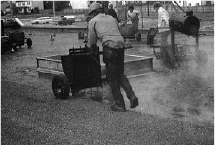The most common type of surfacing used on conventional built-up roofing systems is mineral aggregate and slag. The mineral aggregate can be pea gravel, crushed granite, dolomite or any other form of crushed or river washed stone that is opaque to light, characterized by appropriate size distribution, hardness and is relatively free of dust. ASTM D1863 Standard Specification for Mineral Aggregate Used on Built-Up Roofs provides specific requirements for built-up roof membrane surfacing aggregate. Slag is a by-product from the production of steel. The surfacing protects the membrane from ultra violet rays of the sun and mechanical damage from foot traffic and impacts. It also makes the built-up roof resistant to fire from without.
The surfacing is applied into a flood coat of asphalt directly on the membrane. The membrane surface must be clean and dry to provide good adhesion.
There are three major steps for applying mineral aggregate surfacing to a conventional built-up roof design are:
- Apply the flood coat
- Heat the asphalt and pour it over the built-up plies using either a dipper, a pour can, or a mini-mopper. Always use the type of asphalt designed for the roof slope.
- Type 1 for slopes up to 1:16
- Type 2 for slopes between 1:16 to 1:8
- Type 3 for slopes between 1:8 to 1:4
- Apply the asphalt at a rate of 3 kg/m² (60 lb/square). Ensure a uniform coating.
- Begin the application at the high point of the slope and pour asphalt perpendicular to the roof slope. Gravity will cause the asphalt to run down the slope.
- Apply mineral aggregate into the hot asphalt.
- Heat the asphalt and pour it over the built-up plies using either a dipper, a pour can, or a mini-mopper. Always use the type of asphalt designed for the roof slope.
- Apply the gravel or slag.
 After the flood coat has been applied, the mineral aggregate is applied. Crushed granite, pea gravel, and slag are the most common types of surfacing used. The mineral aggregate must be dry clean and well graded. The size of the mineral aggregate should be between 6 mm to 19 mm (1/4 in to 3/4 in). To install the mineral aggregate:
After the flood coat has been applied, the mineral aggregate is applied. Crushed granite, pea gravel, and slag are the most common types of surfacing used. The mineral aggregate must be dry clean and well graded. The size of the mineral aggregate should be between 6 mm to 19 mm (1/4 in to 3/4 in). To install the mineral aggregate:
- Apply the mineral aggregate immediately into the hot asphalt using either a scoop shovel, gravel pusher, or a gravel spreader.
- Apply the mineral aggregate at a minimum rate of 6 kg/m² (400 lb/square).
- Ensure uniform coverage with no asphalt visible. Any bare spots where the aggregate is not embedded in the asphalt must be swept back and re-gravelled.
- Apply a second application of flood coat and mineral aggregate (double pour), if specified.
A double pour is used on all roof corners exposed to the wind, around penthouses, on valleys were excessive water flow will create erosion, and when specified by the archi-tect. To complete a double pour:- Sweep the roof to remove all loose aggregate from the first application of flood coat
and aggregate. - Apply a second flood coat of asphalt at a rate of 3 kg/m² (60 lb/square).
- While hot, embed the aggregate. The rate for the total amount of mineral aggregate
for both applications should not be less than 19.6 kg/m² (400 lb/square).
- Sweep the roof to remove all loose aggregate from the first application of flood coat
Note: A double pour is not recommended on roof slopes over 1:25.
